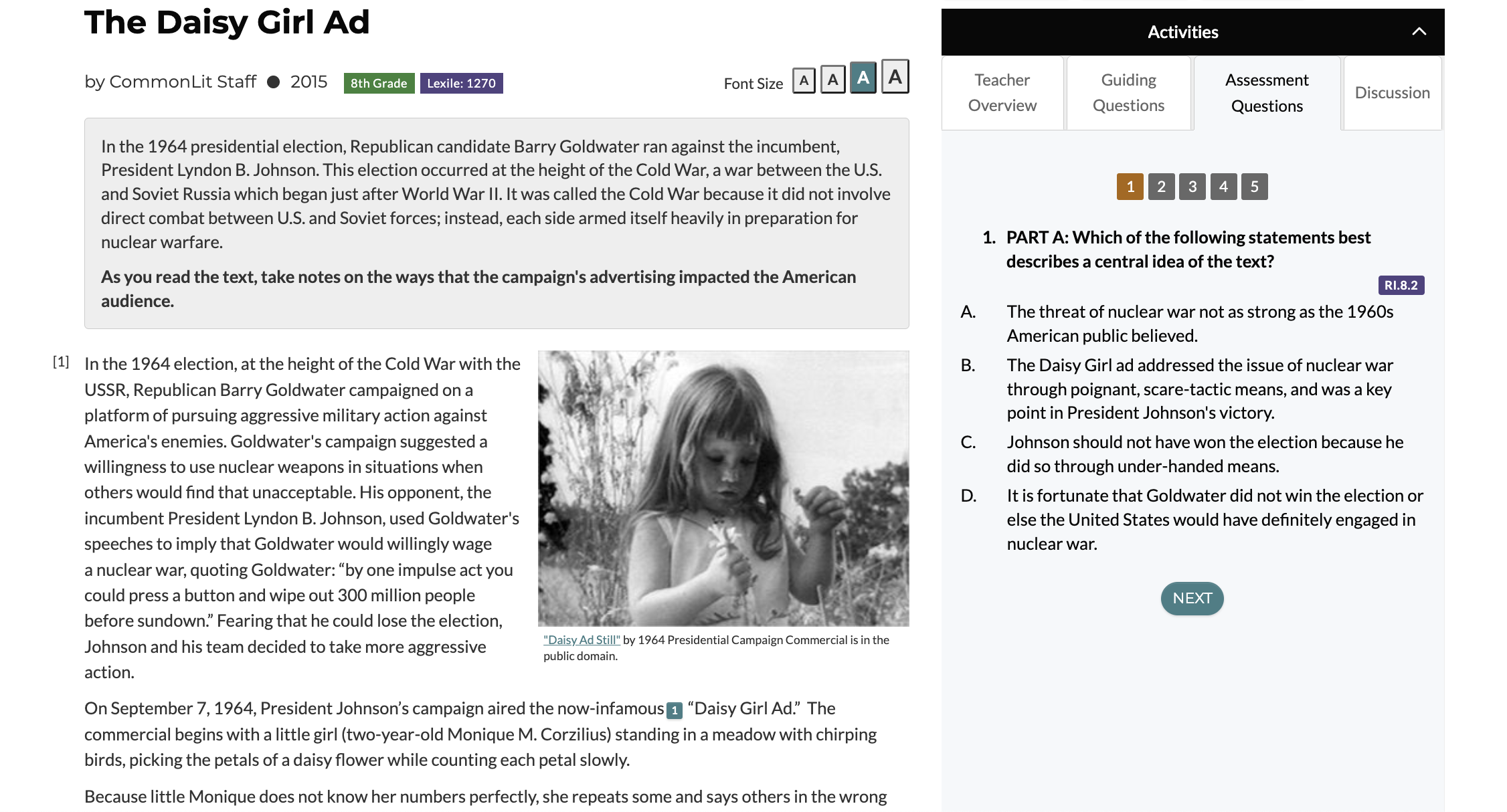Elevate your book unit on George Orwell’s dystopian novel 1984 with informative and engaging texts for high school students.
CommonLit’s free online reading program offers more than 100 Book Pairings, which are complementary resources that encourage students to make connections across specific texts to build their reading comprehension and critical thinking skills.
CommonLit’s Book Pairing for 1984
In this blog post, we’ll review the Book Pairing for George Orwell’s novel 1984. The Book Pairing provides a summary for each text, explains how the text relates to the novel, and suggests where in the book teachers can introduce the text.
Set in a futuristic London, 1984 follows the story of Winston Smith, a man who attempts to rebel against a totalitarian government, known as “Big Brother.” Big Brother controls many aspects of its citizens’ lives through censorship and fearmongering.
Build Background Knowledge on Dystopian Literature
In the novel, Orwell presents government surveillance and social conformity as components that create a dystopian society. As students prepare to read the novel, they can learn more about the dystopian genre through the following texts.
“Someone Might Be Watching — An Introduction to Dystopian Fiction” by Shelby Ostergaard
In this informational text, Shelby Ostergaard explains the elements of dystopian fiction and how the genre originated. Ostergaard also highlights other dystopian novels, like Brave New World, The Handmaid's Tale, and The Hunger Games.
This text is a great choice to introduce students to dystopian literature. After students finish reading the text, lead a classroom discussion on the elements of dystopian fiction and how they relate to the real world. Ask students the following questions: “How are fictional worlds able to comment on the real world? What types of connections are typically drawn and what kind of commentaries are made?”

“Why Do People Follow the Crowd?” by ABC News
Dr. Gregory Berns, a behavioral scientist, conducted social experiments to understand why humans conform. ABC’s Primetime recreated these experiments with unsuspecting participants and concluded that humans conform in order to belong.
Similarly, in Book One: Chapter One, Winston participates in the “Two Minutes Hate,” during which the government presents the image of the enemy on a screen, requiring people to yell and curse at it. Initially, Winston is stunned by how people immediately get upset by the image, until he finds himself imitating their behavior.
After students finish reading this chapter, encourage them to identify evidence from the article to explain why Winston mimics the actions of the people around him.
Explore Real-World Examples of Themes from the Novel
In 1984, Big Brother limits and manipulates information to drive fear and obedience in its citizens. The following informational texts provide real-world examples of censorship and propaganda, which teachers can use to challenge their students to make text-to-world connections.
“I Am Very Real” by Kurt Vonnegut
In November 1973, author Kurt Vonnegut wrote this letter to an English teacher who burned 32 copies of Vonnegut’s novel Slaughter-House Five due to its use of obscene language. Vonnegut criticized the teacher’s actions, arguing that humans have fought for free speech throughout history.
When students reach Book One: Chapter Four, ask them to take notes on the ways Big Brother controls information. Also, encourage students to examine the connection between the central idea of Vonnegut’s letter and the events of the chapter in the novel.
“Total Control in North Korea” by Jessica McBirney
This informational text describes life in North Korea, where the government holds total control of the economy, the military, and education, driving mass obedience among its citizens.
Both 1984 and this article present life under a dictatorial government that maintains power through deception. In the novel, Winston serves as an employee for the Ministry of Truth, a bureaucracy that spreads misinformation.
When students finish Book One: Chapter Four, have them compare and contrast how the totalitarian governments in both texts influence citizens to be obedient.
“The Daisy Girl Ad” by CommonLit Staff
Incumbent President Lyndon B. Johnson launched the controversial “Daisy Girl Ad,” which harnessed people's fear about the Cold War. Many attribute his victory in the 1964 presidential election to this persuasive ad.
Throughout 1984, the government uses propaganda and fearmongering to maintain power. After students finish reading the novel, ask them to compare and contrast Big Brother’s propaganda with the “Daisy Girl Ad.” Then, lead a classroom discussion with the following questions: “How are people’s actions and beliefs influenced by propaganda? How does the government, and O’Brien in particular, influence Winston's beliefs through the use of fear and propaganda?”

Make Text-to-Text Connections about the Human Experience
As Winston defies Big Brother by breaking the government’s rules, he embraces the human experience by following his desires, starting a romantic relationship, and gaining new knowledge. Guide students as they explore the themes of love and knowledge through the following texts.
“Sonnet 18” by William Shakespeare
One of Shakespeare’s most famous love poems, “Sonnet 18,” describes the beauty and wonders of love.
In the middle of 1984, Winston begins a romantic relationship with a woman named Julia, breaking government laws. After reading Book Two: Chapter Two of 1984, students can compare and contrast Winston’s romantic experience with the speaker’s in “Sonnet 18.” Ask students the following question: “How does love affect them both?”
“Allegory of the Cave” by Plato
In this philosophical text, Plato explores the importance of knowledge for society and the human soul.
Towards the end of 1984, Winston is captured and forced to abide by the government’s tyrannical ruling. After students finish reading the novel, have them compare and contrast the experiences of the prisoners in Plato’s cave and Winston in Orwell’s dystopia. Invite students to discuss the following questions: “How are the journeys of Winston and the humans born in the cave similar? In our modern society, how can we avoid a fate similar to Winton’s?”
Bonus
Check out CommonLit 360 if you want a complete unit plan for 9th graders that is centered on the theme of conformity. This unit includes full lesson plans, writing prompts, and much more.
CommonLit 360 is a free, comprehensive ELA curriculum that has engaging, grade-level aligned units. Each unit includes complete lessons with pacing options, so teachers can save time on curriculum planning and focus on classroom engagement.
Next Steps
Looking for more book pairings on CommonLit? Browse the CommonLit Library!
If you’re interested in learning all about CommonLit’s free digital literacy program, join one of our upcoming webinars!


